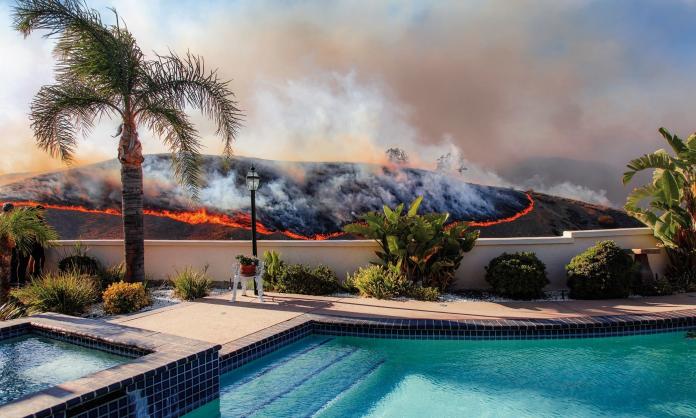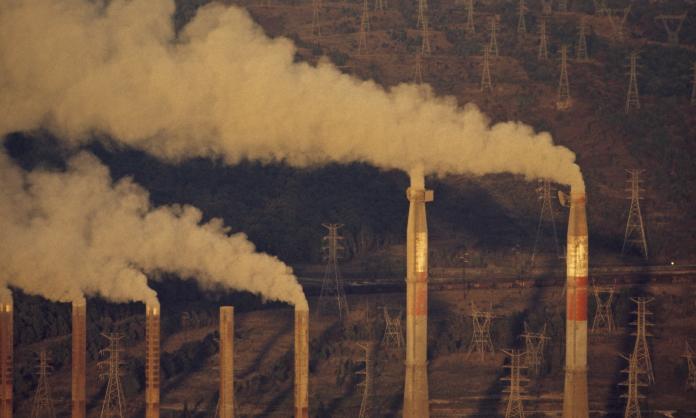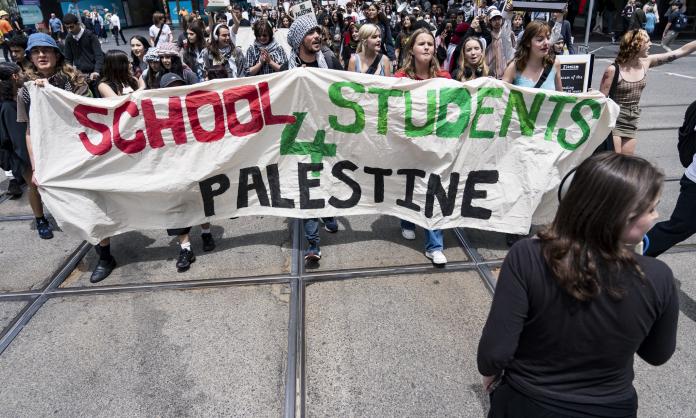The unfolding climate and environmental catastrophe is an existential threat to human society. In the face of this threat, it’s commonly thought our best hope lies in convincing those in power of the need for change. But it’s wrong to believe that “we’re all in this together” and that those in charge can be pushed into action by the arguments of scientists or the lobbying of environmentalists.
The clearest evidence for this is the failure of such efforts over the past few decades. Every year brings new signs of the urgency of reducing emissions and halting other environmentally destructive practices. Every year, scientists produce new reports that meticulously outline the case for change. But the reports and global summits come and go, and the system just keeps marching steadily along its destructive path.
The struggle to save society from climate catastrophe isn’t primarily a battle of ideas. If it were, the weight of scientific evidence would already have gotten us over the line. The struggle is a class war – one that pits the billions of workers and the poor, who make up most of the world’s population, against the minority capitalist ruling class and its political servants, who watch the world burn in the name of profits and power.
School strike for climate leader Greta Thunberg has been clearer than most when it comes to identifying the class dynamics inherent in the climate crisis. “Some people say the climate crisis is something that we [all] have created”, she said during a speech to the World Economic Forum’s annual gathering of global elites in Davos, Switzerland, in January last year. “But that is not true. Because if everyone is guilty, then no one is to blame. And someone is to blame. Some people, some companies, some decision-makers in particular, have known exactly what priceless values they have been sacrificing to continue making unimaginable amounts of money. And I think many of you here today belong to that group of people.”
The global ruling class bears a double responsibility for the climate and environmental catastrophe. Its members historically have made all the decisions that put society on its destructive course. And they’re also the ones who continue to defend capitalist “business as usual” from any challenge by environmentalists or others fighting for a better world.
……………….
The development of capitalism into the fossil fuel-guzzling, pollution-spewing and ecosystem-destroying monster it is today wasn’t automatic. From the earliest days of the industrial revolution, the system was consciously shaped by those in power to maximise their wealth at the cost of both workers and the environment.
In his book Fossil Capital: The Rise of Steam Power and the Roots of Global Warming, Andreas Malm disproves the common assumption that the growing use of coal during the industrial revolution of the early 19th century was a natural and inevitable development. Up to that point, the main source of power in the rapidly industrialising English cotton industry was water mills. Therefore, cotton manufacturing was concentrated in the river valleys of northern England and Scotland.
The water mills were cheaper and more efficient than coal-fired steam engines. But they had two significant drawbacks from a capitalist perspective. First, they required a degree of cooperation between mill owners to ensure everyone had access to the necessary quantities of running water. This was very difficult in a system built on competition. Second, the best locations for water mills were in the countryside, which made it difficult to source and maintain a pliant labour force.
The remoteness of the mills and their dependence on small pools of local workers encouraged a higher degree of organisation and assertiveness among the latter. When it came to negotiations with their workers over pay, conditions and so on, the bosses in these areas were in a much worse position than those operating within the more populous and transient communities of the cities.
The rapid rise of coal as a source of power can’t be explained without reference to these early class conflicts. Coal-fired steam engines were more expensive than the water mills, but they provided the capitalists with a big advantage when it came to exploiting workers. The engines could be turned on or off at any time, without relying on the flow of water or anything else, meaning factories could operate 24 hours a day. The engines could also be set up in the cities rather than the countryside, giving factory owners access to a much bigger, and more desperate, supply of labour.
For the capitalists, this was a golden age. Industry expanded at breakneck speed. Profits soared. For the workers, it was a disaster. Rural communities were decimated; millions were forced off the land and into overcrowded and disease-ridden slums. The life expectancy of workers in major industrial centres like Manchester plunged to as low as 17 years.
Another example is the rise of the private car. Until the middle of the 20th century, most people in urban centres relied on public transport to get around. From the 1940s, governments and big business conspired to run down public transport systems, forcing more and more people into dependency on cars. This was very good for business, but very bad for the millions of people enduring constant traffic jams in endlessly sprawling cities. And, of course, it was also very bad for the environment.
If, instead of running down or ripping up public transport systems, our rulers had maintained and further built on those systems, the cities of today would be vastly more liveable and more sustainable than they are. As it is, we’re forced to rely on shoddy, expensive and overcrowded public transport while governments continue to invest billions in new freeways and other projects that provide windfall profits to construction and transport companies while doing nothing to reduce congestion or improve sustainability.
A more recent example is the cover-up by fossil fuel industry executives of research they commissioned in the 1980s, which showed beyond doubt the connection between increasing carbon emissions and global warming. In 1982, executives from global oil giant Exxon were briefed by scientists who predicted that warming would cause significant sea level rises and desertification across wide areas of the US and other countries.
The conclusion of the executives was not that they should find alternatives to fossil fuels. Instead, from the late 1980s, Exxon and other major fossil fuel companies spent tens of millions of dollars ensuring that no serious action was taken. Despite the increasing clamour of scientists, emissions continued their steady rise. If Exxon and Co. had taken the advice of their own scientists and begun developing the technology and infrastructure for a renewable energy system, the situation today would be very different. Instead, they ignored the advice and continued to expand the fossil fuel economy.
……………….
Judging by their past record, you could make a strong case for many in the global ruling class to be tried for crimes against humanity. A 2012 report by DARA, a non-government organisation, found that 400,000 people were dying every year as a result of climate change. When other destructive impacts of the fossil fuel industry such as air pollution were factored in, the figure rose to 4.5 million.
Perhaps the greatest crime, however, is that in the face of all the evidence, our rulers continue to fight tooth and nail to defend their system against anyone who challenges it. Wherever we look, the pattern is the same. Governments are doing very little to reduce carbon emissions or tackle other aspects of the environmental crisis, but they’re doing a lot when it comes to preparing for a future in which their system and the profits of the capitalist class they serve are likely to be threatened by growing instability and unrest.
There are three aspects to this. First, they’re bolstering militaries tasked with maintaining security (read: protecting capitalist profits) internationally. They recognise that ecosystem collapse, the increasing frequency of natural disasters and so on will increase the potential for conflict, and governments around the world are scrambling to ensure they’re the ones who win out. Second, they’re spending hundreds of millions on border walls and detention centres to keep desperate people out. And third, they’re passing new laws and giving police more resources and powers to repress protesters at home.
Australia is on the cutting edge of all this. Politicians such as Scott Morrison feign ignorance about the potentially catastrophic impacts of climate change. But behind the scenes they’re busy preparing for the worst. For them, however, preparing means something very different than it does for the rest of us. They’re not preparing, for example, to be able to better deal with disasters like this summer’s bushfire crisis. The $2 billion recovery fund established by the government is peanuts compared to the annual military budget of $38.7 billion (which is projected to rise to $58.7 billion by 2025-26). What Morrison and his like are preparing for is a world in which the fossil fuel barons and the rest of the capitalist class will rely more and more on force to get their way.
Our rulers have never believed that “we’re all in this together”. The world they’re building is one in which they will continue to pillage and exploit the environment and workers with impunity – a world of wars and walls, of mass detention of migrants and mass arrests of activists.
……………….
Whereas the global ruling class bears a double responsibility for the climate crisis, the world’s workers and the poor have a double interest in fighting against it. First, workers have nothing to gain from the existing set-up. They’re not the ones reaping billions in profits from the fossil fuel economy. Second, as we’re already seeing today, they’ll be the first to lose when the impacts of climate change and environmental destruction hit.
The government and the opposition Labor Party would have us believe that Australia’s status as a global coal and gas superpower is good for everyone. If that were the case, however, you would expect the industry’s booming profits to have had some impact on overall living standards. Over the past five years, however, we’ve had the longest sustained fall in household disposable income in Australia in decades. Wages are flat at best, and it’s getting harder and harder to find decent, secure employment.
Even if you consider the relatively small number employed directly by the mining industry, such as the 37,800 who, according to the Australian Bureau of Statistics, work in coal mining, it’s not like they’re living a life of luxury and leisure. Wages growth in mining has been just as flat as in the rest of the economy. Mining companies have aggressively targeted unions and tried to undermine hard-won industry standards on wages and conditions. And there’s also a resurgence of black lung disease – a potentially fatal condition caused by prolonged exposure to coal dust – more than 100 cases being confirmed in Queensland.
When you look beyond Australia, it’s even clearer. It’s only thanks to a long history of trade unionism that work in Australia’s fossil fuel industry is regarded as something of a privilege to be defended. In most parts of the world, workers in these industries are paid a pittance for long hours of very dangerous, health-destroying labour.
The world’s working class would be better off without these industries. Already, the technology exists for a transition away from fossil fuels to a 100 percent renewable energy system. Talk of having to protect mining industry jobs is just an excuse for more foot dragging by governments who will do everything they can to keep the profit bonanza going. Australia and other developed countries are wealthy enough to fund a rapid transition to renewables without throwing mining workers on the scrap heap.
The alternative doesn’t bear contemplating. Australia’s summer of fire is just a small taste of what’s to come if we fail to shift society from its destructive path. And while the ruling class and its political servants can protect themselves from the worst of the effects, the rest of us won’t be so lucky. The climate crisis and environmental breakdown will, increasingly, add yet another burden to an existence that for many is already highly precarious. The threat to our homes, livelihoods and ultimately our lives will work its way into the fabric of our daily reality.
A placard at a 40,000-strong protest in Sydney at the height of the bushfire crisis in December had it right: “No one is coming to save us, except us”. As long as there are profits to be made from the exploitation of the world’s workers and the environment, the capitalist ruling class will never be convinced of the need for change. If we’re going to save our precious planet, and win a just and sustainable future, we need to unite into a movement powerful enough to smash their rotten system for good.











